Direct Current Annealing Modulated Ordered Structure to Optimize Tensile Mechanical Properties of Co-Based Amorphous Metallic Microwires
Abstract
:1. Introduction
2. Materials and Methods
3. Results and Discussion
3.1. Direct Current Annealing and Structure Characteristic
3.2. Tensile Properties and Fracture Morphology of Co-Based Metallic Microwires
3.3. Fracture Reliability Analysis of Co-Based Metallic Microwires
4. Conclusions
- (1)
- Direct current-annealing can promote the formation of nanoclusters in the amorphous structure of Co-based metallic microwires, and with the rising of the annealing current intensity, whose content increases, the distribution tends to be concentrated from dispersion;
- (2)
- Direct current-annealing with appropriate strength can effectively improve the tensile strength and elongation at the break of Co-based metallic microwires, and also enhance their fracture reliability. The 90 mA current-annealed metallic microwires have excellent tensile mechanical properties, the tensile strength and elongation at break are 4540.10 MPa and 2.99%, respectively, and the fracture threshold is 1910.90 MPa;
- (3)
- The way to improve the tensile mechanical properties of Co-based metallic microwires is to control the content and distribution of the nanoclusters. The small and uniformly distributed nanoclusters can hinder the expansion of shear bands, while the larger and concentrated nanoclusters may become the initiation points of shear bands and accelerate the generation of cracks.
Author Contributions
Funding
Institutional Review Board Statement
Informed Consent Statement
Data Availability Statement
Conflicts of Interest
References
- Schuh, C.A.; Hufnagel, T.C.; Ramamurty, U. Mechanical Behavior of Amorphous Alloys. Acta Mater. 2007, 55, 4067–4109. [Google Scholar] [CrossRef]
- Ding, D.J.; Huang, J.Z.; Deng, X.L.; Fu, K. Recent Advances and Perspectives of Nanostructured Amorphous Alloys in Electrochemical Water Electrolysis. Energy Fuels 2021, 35, 15472–15488. [Google Scholar] [CrossRef]
- Suryanarayana, C.; Inoue, A. Iron-based Bulk Metallic Glasses. Int. Mater. Rev. 2013, 58, 131–166. [Google Scholar] [CrossRef]
- Wang, W.H.; Dong, C.; Shek, C.H. Bulk Metallic Glasses. Mater. Sci. Eng. R-Rep. 2004, 44, 45–89. [Google Scholar] [CrossRef]
- Li, X.; Cai, W.Z.; Li, D.S.; Xu, J.; Tao, H.B.; Liu, B. Amorphous Alloys for Electrocatalysis: The Significant Role of the Amorphous Alloy Structure. Nano Res. 2021. [Google Scholar] [CrossRef]
- Gonzalez, A.; Zhukova, V.; CorteLeon, P.; Chizhik, A.; Ipatov, M.; Blanco, J.M.; Zhukov, A. Tuning of Magnetoimpedance Effect and Magnetic Properties of Fe-Rich Glass-Coated Microwires by Joule Heating. Sensors 2022, 22, 1053. [Google Scholar] [CrossRef]
- Jiang, S.D.; Wang, H.; Estevez, D.N.; Huang, Y.J.; Zhang, L.Y.; Shen, H.X.; Ning, Z.L.; Qin, F.X.; Sun, J.F. Surface Microstructural Design to Improve Mechanical and Giant Magneto-Impedance Properties of Melt-extracted CoFe-based Amorphous Wires. Mater. Des. 2021, 204, 109642. [Google Scholar] [CrossRef]
- Liu, J.S.; Zhang, Y.; Wang, Q.X.; Wu, M.J.; Nan, D.; Shen, H.X.; Peng, H.X. Enhanced Tensile Properties and Fracture Reliability of Cu-based Amorphous Wires via Pr-doping. Adv. Eng. Mater. 2018, 20, 1700935. [Google Scholar] [CrossRef]
- Shen, H.X.; Liu, J.S.; Wang, H.; Xing, D.W.; Chen, D.M.; Liu, Y.F.; Sun, J.F. Optimization of Mechanical and Giant Magneto-impedance (GMI) Properties of Melt-extracted Co-rich Amorphous Microwires. Phys. Status Solidi A-Appl. Mater. Sci. 2014, 211, 1668–1673. [Google Scholar] [CrossRef]
- Ogasawara, I.; Ueno, S.; Ohmichi, T. Preparation and Properties of Amorphous Wires. IEEE Trans. Magn. 1981, 31, 1219–1223. [Google Scholar] [CrossRef]
- Chiriac, H.; Óvári, T.A. Amorphous Glass-covered Magnetic Wires: Preparation, Properties, Applications. Prog. Mater. Sci. 1996, 40, 333–407. [Google Scholar] [CrossRef]
- Larin, V.S.; Torcunov, A.V.; Zhukov, A.; Gonzalez, J.; Vazquez, M.; Panina, L. Preparation and Properties of Glass-coated Microwires. J. Magn. Magn. Mater. 2002, 249, 39–45. [Google Scholar] [CrossRef]
- Atalay, F.E.; Kaya, H.; Atalay, S. Magnetoimpedance Effect in Electroplated NiFeRu/Cu Wire. J. Phys. D Appl. Phys. 2006, 39, 431–436. [Google Scholar] [CrossRef]
- Garcia, J.M.; Sinnecker, J.P.; Asenjo, A.; Vazquez, M. Enhanced Magnetoimpedance in CoP Electrodeposited Microtubes. J. Magn. Magn. Mater. 2001, 226, 704–706. [Google Scholar] [CrossRef]
- Mishra, A.C.; Sahoo, T.; Srinivas, V.; Thakur, A.K. Giant Magnetoimpedance in Electrodeposited CoNiFe/Cu Wire: A Study on Thickness Dependence. J. Alloys Compd. 2009, 480, 771–776. [Google Scholar] [CrossRef]
- Shen, H.X.; Wang, H.; Liu, J.S.; Xing, D.W.; Qin, F.X.; Cao, F.Y.; Chen, D.M.; Liu, Y.F.; Sun, J.F. Enhanced Magnetocaloric and Mechanical Properties of Melt-extracted Gd55Al25Co20 Micro-fibers. J. Alloys Compd. 2014, 603, 167–171. [Google Scholar] [CrossRef]
- Inoue, A.; Amiya, K.; Katsuya, A.; Masumoto, T. Mechanical Properties and Thermal Stability of Ti- and Al-based Amorphous Wires Prepared by a Melt Extraction Method. Mater. Trans. JIM 1995, 36, 858–865. [Google Scholar] [CrossRef]
- Nematov, M.G.; Baraban, I.; Yudanov, N.A.; Rodionova, V.; Qin, F.X.; Peng, H.X.; Panina, L.V. Evolution of the Magnetic Anisotropy and Magnetostriction in Co-based Amorphous Alloys Microwires due to Current Annealing and Stress-sensory Applications. J. Alloys Compd. 2020, 837, 155584. [Google Scholar] [CrossRef]
- Zhang, M.W.; Qu, G.D.; Liu, J.S.; Pang, M.Y.; Wang, X.F.; Liu, R.; Cao, G.Y.; Ma, G.X. Enhancement of Magnetic and Tensile Mechanical Performances in Fe-based Metallic Microwires Induced by Trace Ni-doping. Materials 2021, 14, 3589. [Google Scholar] [CrossRef]
- Liu, J.S.; Wang, X.F.; Li, Z.; Zhang, Y.; Cao, G.Y.; Huang, M.F.; Shen, H.X. Oil-medium Current Annealing Enhanced Giant Magneto-impedance Properties of Co-based Metallic Microfibers for Magnetic Sensor Applications. Mater. Today Commun. 2019, 20, 100605. [Google Scholar] [CrossRef]
- Liu, R.; Cao, G.Y.; Liu, J.S.; Li, Z.; Zhang, Y.; Liu, Z.T. Comparative Study on GMI Properties of Co-based Microwires Improved by Alcohol and Liquid Nitrogen Medium-Current Annealing. Mater. Res. Express 2021, 8, 065202. [Google Scholar] [CrossRef]
- Corte-Leon, P.; Zhukova, V.; Blanco, J.M.; González-Legarreta, L.; Ipatov, M.; Zhukov, A. Stress-induced Magnetic Anisotropy Enabling Engineering of Magnetic Softness of Fe-rich Amorphous Microwires. J. Magn. Magn. Mater. 2020, 510, 166939. [Google Scholar] [CrossRef]
- Dzhumazoda, A.; Panina, L.V.; Nematov, M.G.; Ukhasov, A.A.; Yudanov, N.A.; Morchenko, A.T.; Qin, F.X. Temperature-stable Magnetoimpedance (MI) of Current-annealed Co-based Amorphous Microwires. J. Magn. Magn. Mater. 2019, 474, 374–380. [Google Scholar] [CrossRef]
- Thiabgoh, O.; Shen, H.; Eggers, T.; Galati, A.; Jiang, S.; Liu, J.S.; Li, Z.; Sun, J.F.; Srikanth, H.; Phan, M.H. Enhanced High-frequency Magneto-impedance Response of Melt-extracted Co69.25Fe4.25Si13B13.5 Microwires Subject to Joule Annealing. J. Sci. Adv. Mater. Devices 2016, 1, 69–74. [Google Scholar] [CrossRef]
- Liu, J.S.; Li, Z.; Jiang, S.D.; Du, Z.X.; Shen, H.X.; Zhang, L.Y. Multiplex Magnetic Field Annealing Evoked Remarkable GMI Improvement in Co-based Amorphous Wires. J. Alloys Compd. 2016, 683, 7–14. [Google Scholar] [CrossRef]
- Prida, V.M.; Badini, G.; Vega, V.; Perez, M.J.; Batallan, F.; Vazquez, M. Magnetic Properties of Field Annealed Ni-rich Microwires. J. Non-Cryst. Solids 2007, 353, 931–934. [Google Scholar] [CrossRef]
- Corte-León, P.; Zhukova, V.; Ipatov, M.; Blanco, J.M.; Gonzalez, J.; Dominguez, L.; Churyukanova, M.; Zhukov, A. High Frequency Giant Magnetoimpedance Effect of a Stress-annealed Fe-rich Glass-coated Microwire. J. Alloys Compd. 2019, 802, 112–117. [Google Scholar] [CrossRef]
- Zhukov, A.; Zhukova, V.; Larin, V.; Gonzalez, J. Tailoring of Magnetic Anisotropy of Fe-rich Microwires by Stress Induced Anisotropy. Phys. B Condens. Matter 2006, 384, 1–4. [Google Scholar] [CrossRef]
- Zhukova, V.; Ipatov, M.; Talaat, A.; Blanco, J.M.; Churyukanova, M.; Zhukov, A. Effect of Stress Annealing on Magnetic Properties and GMI Effect of Co-rich and Fe-rich Microwires. J. Alloys Compd. 2017, 707, 189–194. [Google Scholar] [CrossRef]
- Wang, H.; Qin, F.X.; Xing, D.W.; Cao, F.Y.; Wang, X.D.; Peng, H.X.; Sun, J.F. Relating Residual Stress and Microstructure to Mechanical and Giant Magneto-impedance Properties in Cold-drawn Co-based Amorphous Microwires. Acta Mater. 2012, 60, 5425–5436. [Google Scholar] [CrossRef]
- Shen, H.X.; Xing, D.W.; Sánchez Llamazares, J.L.; Sánchez-Valdés, C.F.; Belliveau, H.; Wang, H.; Qin, F.X.; Liu, Y.F.; Sun, J.F.; Srikanth, H.; et al. Enhanced Refrigerant Capacity in Gd-Al-Co Microwires with a Biphase Nanocrystalline/Amorphous Structure. Appl. Phys. Lett. 2016, 108, 092403. [Google Scholar] [CrossRef]
- Zhukova, V.; Talaat, A.; Ipatov, M.; Del Val, J.J.; Gonzalez-Legarreta, L.; Hernando, B.; Zhukov, A. Effect of Nanocrystallization on Magnetic Properties and GMI Effect of Fe-rich Microwires. J. Electron. Mater. 2014, 43, 4540–4547. [Google Scholar] [CrossRef]
- Liu, J.S.; Huang, M.F.; Wu, M.J.; Zhang, Y.; Cao, G.Y.; Li, Z.; Chen, H.N.; Yu, T.C.; Wang, X.F.; Liu, R.; et al. Effect of Current Annealing Treatment on Magnetic Properties of Gd-Al-Co-Fe Metallic Microfibers. J. Alloys Compd. 2021, 855, 157231. [Google Scholar] [CrossRef]
- Liu, J.S.; Qin, F.X.; Chen, D.M.; Shen, H.X.; Wang, H.; Xing, D.W.; Phan, M.H.; Sun, J.F. Combined Current-modulation Annealing Induced Enhancement of Giant Magnetoimpedance Effect of Co-rich Amorphous Microwires. J. Appl. Phys. 2014, 115, 17A326. [Google Scholar] [CrossRef]
- Liu, J.S.; Cao, F.Y.; Xing, D.W.; Zhang, L.Y.; Qin, F.X.; Peng, H.X.; Xue, X.; Sun, J.F. Enhancing GMI Properties of Melt-extracted Co-based Amorphous Wires by Twin-zone Joule Annealing. J. Alloys Compd. 2012, 541, 215–221. [Google Scholar] [CrossRef]
- Xue, L.; Shao, L.L.; Luo, Q.; Hu, L.N.; Zhao, Y.B.; Yin, K.B.; Zhu, M.Y.; Sun, L.T.; Shen, B.L.; Bian, X.F. Liquid dynamics and glass formation of Gd55Co20Al25 metallic glass with minor Si addition. J. Mater. Sci. Technol. 2021, 77, 28–37. [Google Scholar] [CrossRef]
- Fan, G.Y.; Cowley, J.M. Auto-correlation analysis of high resolution electron micrographs of near-amorphous thin films. Ultramicroscopy 1985, 17, 345–355. [Google Scholar] [CrossRef]

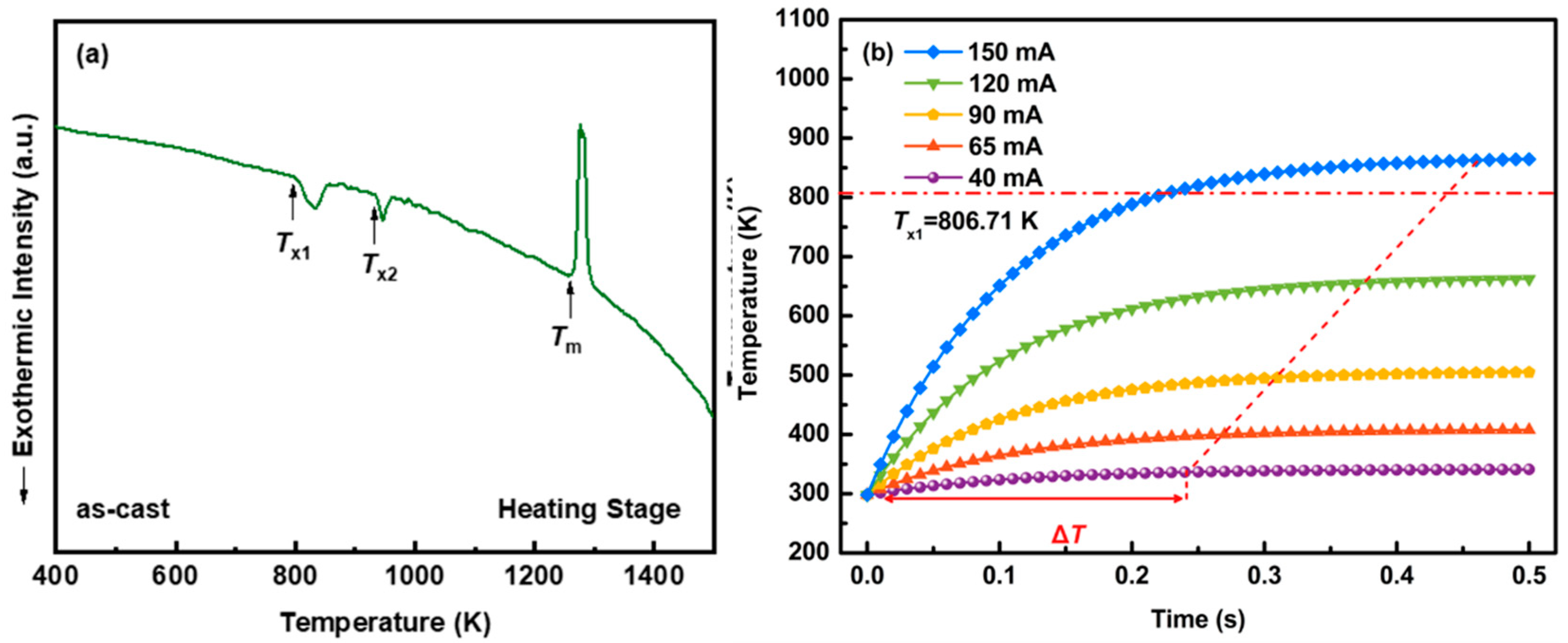
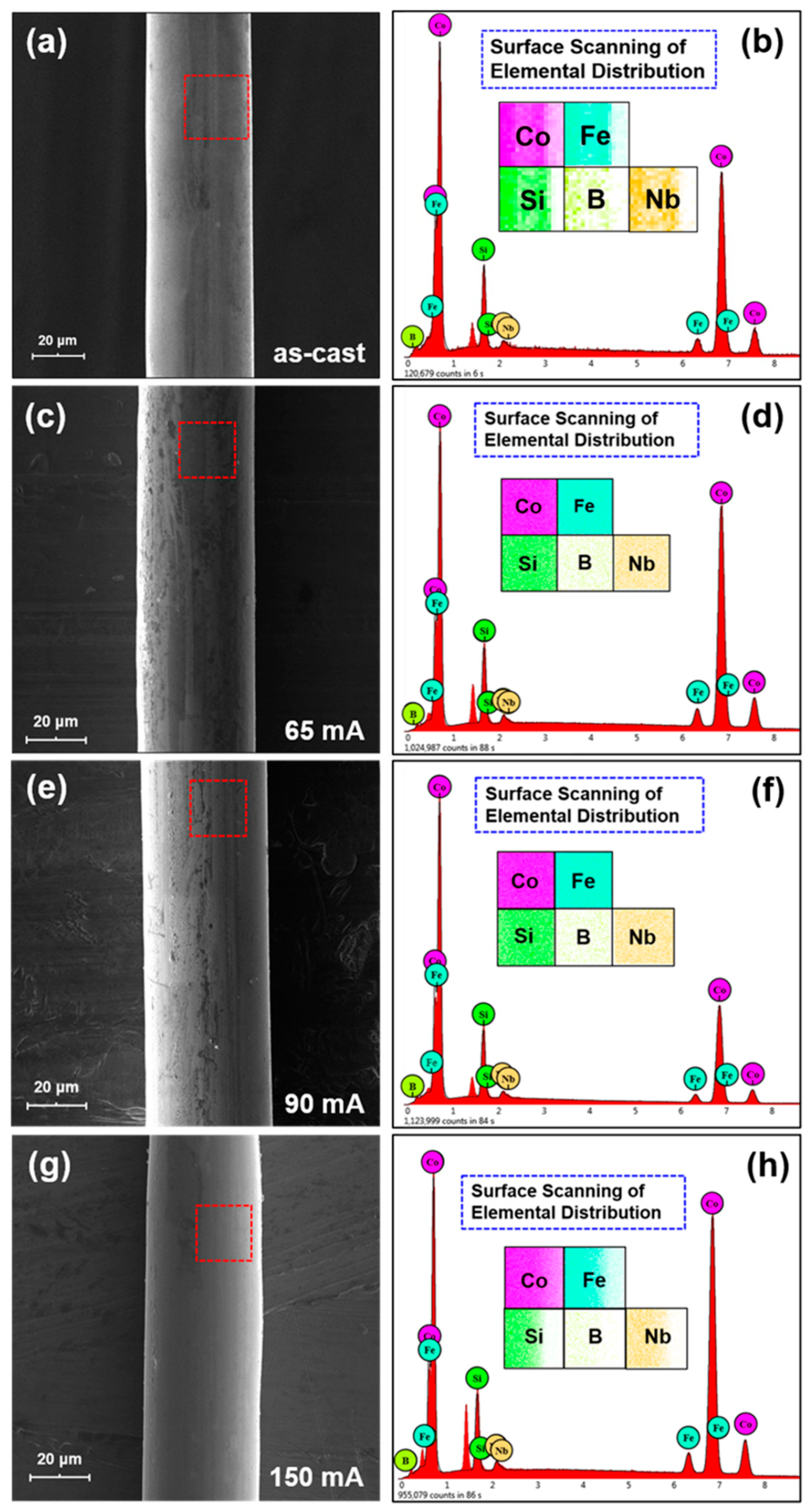
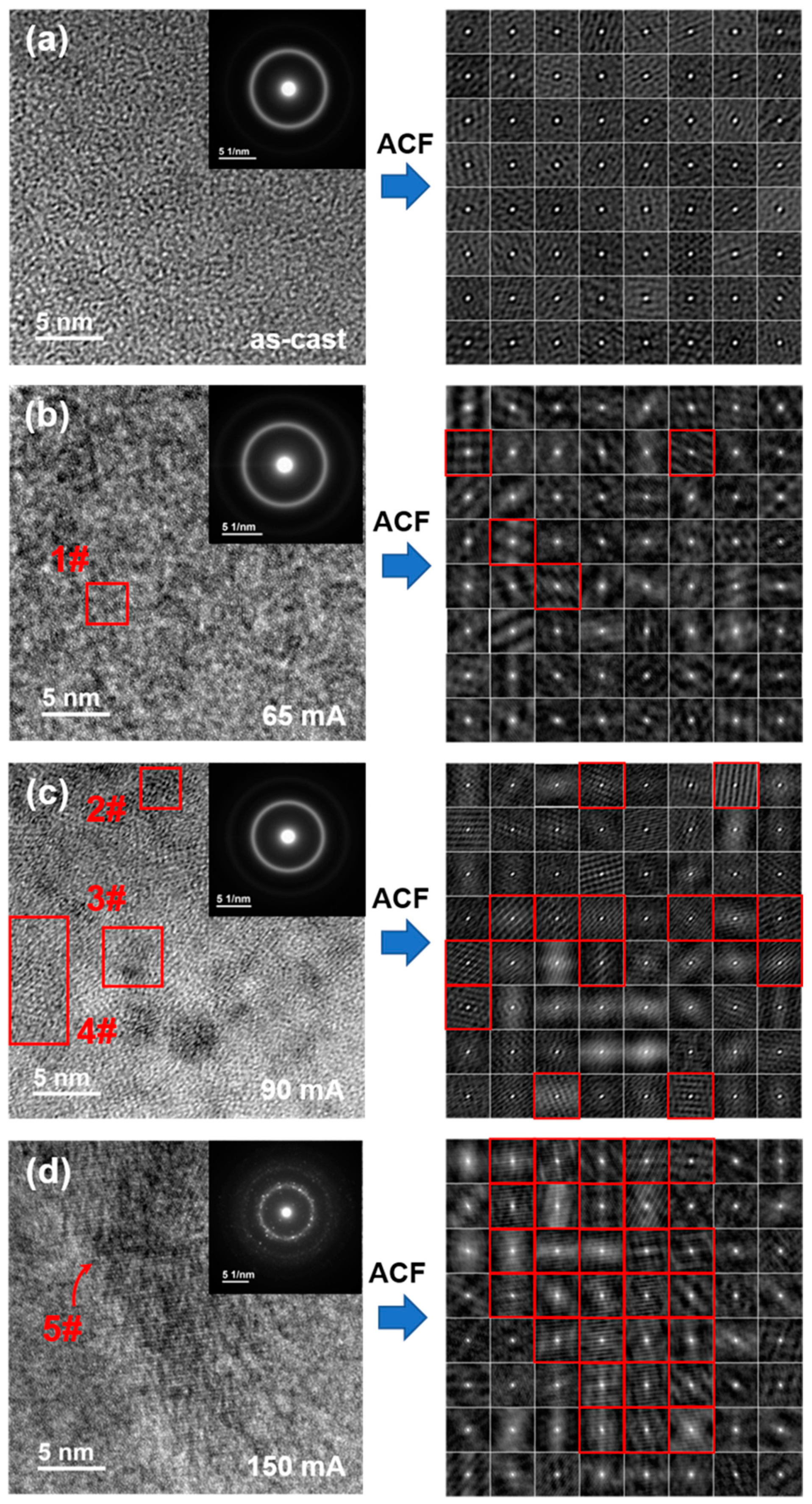
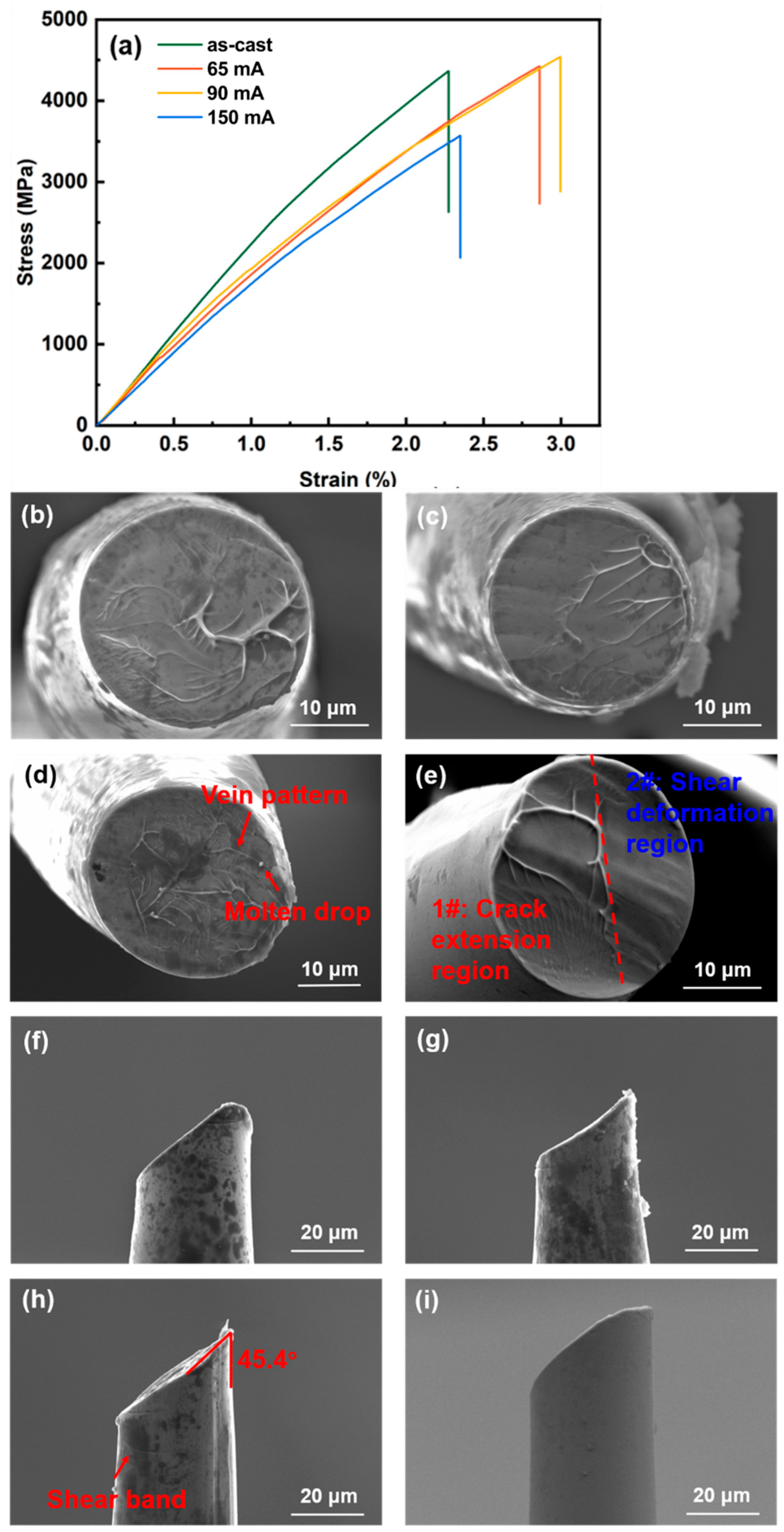
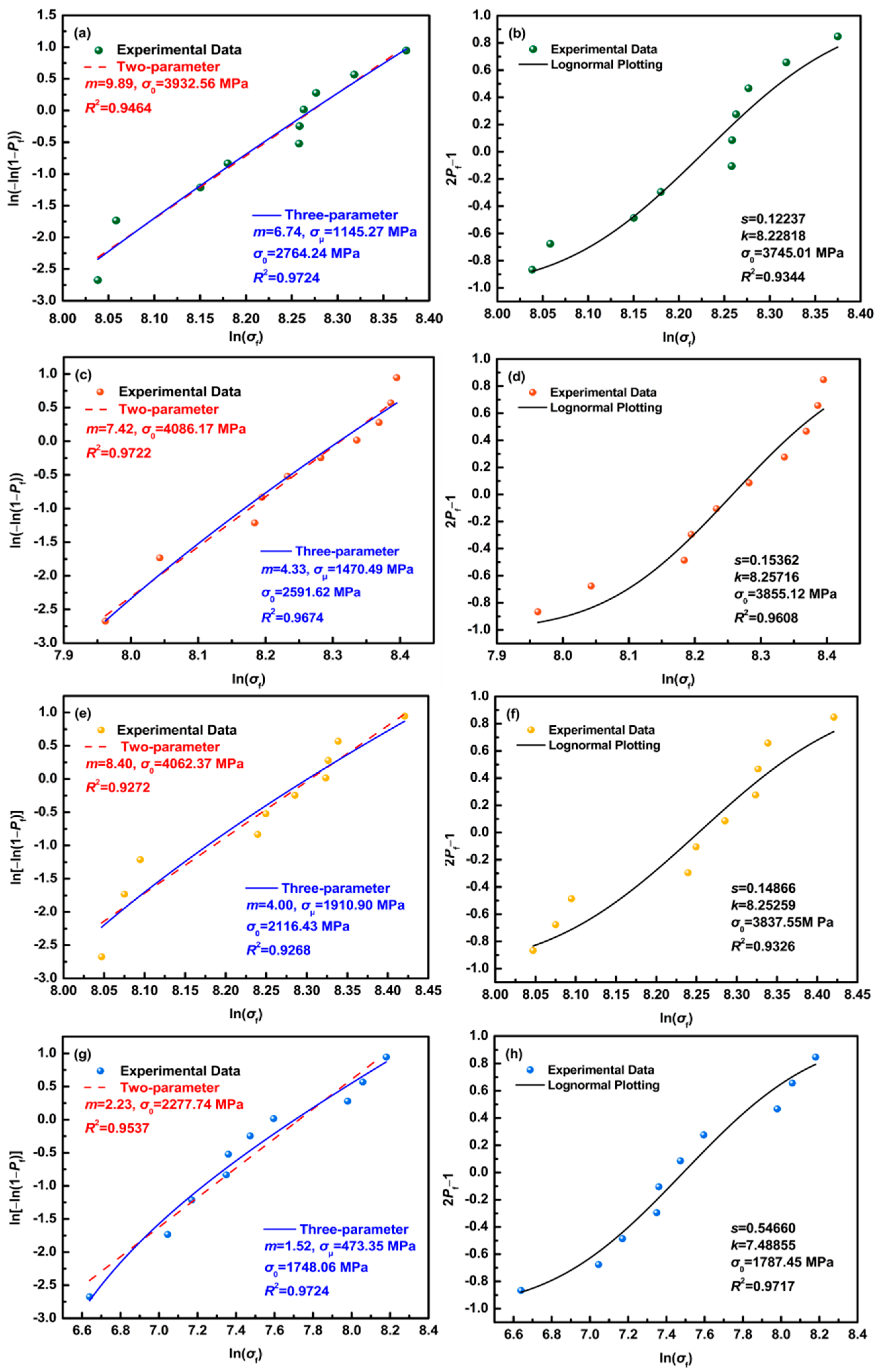
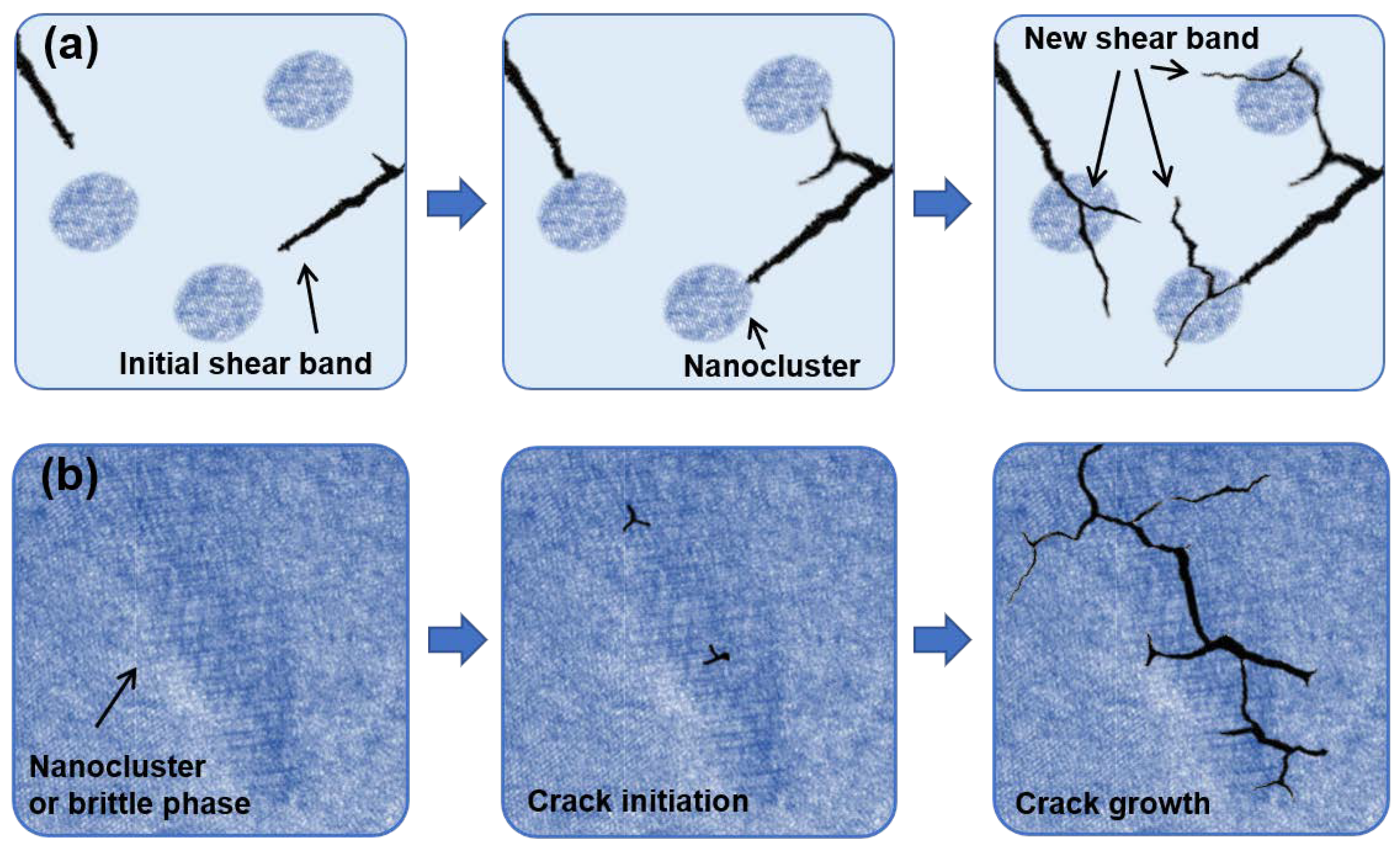
| Elements | Contents (at.%) |
|---|---|
| Co | 69.25 |
| Fe | 4.25 |
| Si | 13.00 |
| B | 12.50 |
| Nd | 1.00 |
| Fitting Type | As-Cast | 65 mA | 90 mA | 150 mA | |
|---|---|---|---|---|---|
| Weibull Statistics | Two-parameter | m = 9.89 | m = 7.42 | m = 8.40 | m = 2.23 |
| Three-parameter | m = 6.74 | m = 4.33 | m = 4.00 | m = 1.52 | |
| σμ = 1145.27 MPa | σμ = 1470.49 MPa | σμ = 1910.90 MPa | σμ = 473.35 MPa | ||
| Log-normal Plotting | s = 0.12237 | s = 0.15362 | s = 0.14866 | s = 0.54660 | |
| k = 8.22818 | k = 8.25716 | k = 8.25259 | k = 7.48855 | ||
Publisher’s Note: MDPI stays neutral with regard to jurisdictional claims in published maps and institutional affiliations. |
© 2022 by the authors. Licensee MDPI, Basel, Switzerland. This article is an open access article distributed under the terms and conditions of the Creative Commons Attribution (CC BY) license (https://creativecommons.org/licenses/by/4.0/).
Share and Cite
Wang, C.; Cao, G.; Liu, J.; Zhang, Y.; Liu, R.; Wang, F.; Zhang, M.; Wang, L.; Zhang, B. Direct Current Annealing Modulated Ordered Structure to Optimize Tensile Mechanical Properties of Co-Based Amorphous Metallic Microwires. Metals 2022, 12, 1427. https://doi.org/10.3390/met12091427
Wang C, Cao G, Liu J, Zhang Y, Liu R, Wang F, Zhang M, Wang L, Zhang B. Direct Current Annealing Modulated Ordered Structure to Optimize Tensile Mechanical Properties of Co-Based Amorphous Metallic Microwires. Metals. 2022; 12(9):1427. https://doi.org/10.3390/met12091427
Chicago/Turabian StyleWang, Congliang, Guanyu Cao, Jingshun Liu, Yun Zhang, Rui Liu, Feng Wang, Mingwei Zhang, Lu Wang, and Bo Zhang. 2022. "Direct Current Annealing Modulated Ordered Structure to Optimize Tensile Mechanical Properties of Co-Based Amorphous Metallic Microwires" Metals 12, no. 9: 1427. https://doi.org/10.3390/met12091427





